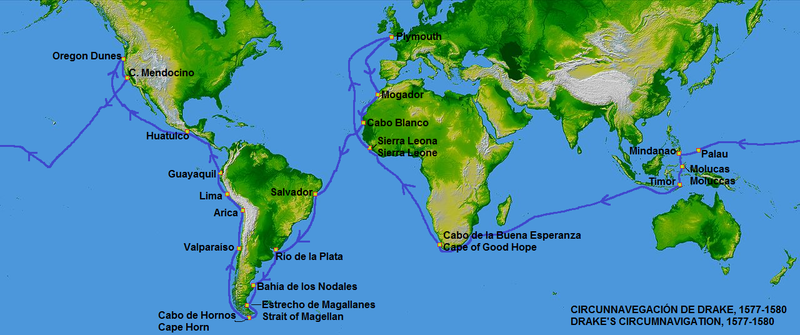Sir Francis Drake was a pirate, sea captain, explorer, and slave trader. The British and the Spanish were at war, but Britain’s empire couldn’t yet compare to the Spanish, so they encouraged piracy, to weaken the Spanish Empire. Sir Francis Drake was the most famous of all these pirates. After the fall of Rome no European empire’s territory reached further than Europe itself, that is, until the 16th century. The Spanish and Portuguese start exploring and colonising new land. In this century Spain developed their seafaring expertise, and used it to expand their empire to the Americas.
The Sea Dog’s Bounty
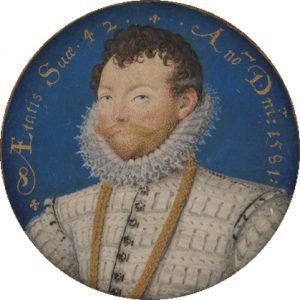
Drake was also known as Britain’s most feared “Sea Dog”. He was hated by the Spanish, and Philip II, King of Spain, put a bounty on his head worth the equivalent of millions in modern day currency. This bounty would have made him a target for thousands, but nobody ever managed to kill him. The bounty was put on his head in 1570, and died of natural causes in 1586.
Circumnavigating The World
Sir Francis Drake was the first person to circumnavigate the world while leading the expedition as captain throughout the entire voyage. He was asked by Queen Elizabeth herself to lead an expedition against the Spanish, however circumnavigating the world, wasn’t part of the plan. In fact, she only wanted him to find information on the Spain’s presence in South and North America. Sir Francis Drake had his own plans. He was ambitious, and decided to travel to the Americas and raid the Spanish for everything he could. He would get rich, and the Spanish would lose a lot of coin. Pleasing both him, and the crown.
He set sail in December, 1577, and reached Brazil in 1578, in the Spring. He led 5 ships, and 200 men, unfortunately not all of them would survive the journey. While in South America, he had one of his officers, Thomas Doughty, executed for mutiny. He then abandoned two of his ships, and set sail into dangerous waters. The situation got so bad that all three ships were separated, and one was claimed by the ocean. Another set sail back home for England, under the belief that Drake’s ship had been sunk.
However, the Golden Hind was still sailing, and worked its way north. One ship may have been all Drake had, but that one ship did more damage than anyone would have expected. The Spanish had never seen an English raider that far from home, and were completely unprepared for it. Drake stripped them dry, robbing treasure ships, and a city. He got away with the equivalent of tens of millions in today’s money. Now, he only had to get back.
The Journey Back
He first travelled far, far north, hoping to find the legendary northern passage, but gave up because the cold weather became unbearable. Instead, he chose to cross the pacific ocean. They were the only ship of five that had made it this far, and had no idea if they would make it back. It took 68 long days before they saw land. They had arrived in South East Asia. While sailing back they struck a reef, and were stuck. They threw everything they could spare overboard, in order to lighten the ship. The wind picked up, and they were lucky enough to be freed. In 1580 they had finally made their way back to England, but almost half of the original crew had died. With the treasure he had brought back, he and his investors had made an enormous profit.
Potatoes, And Drake’s Cultural Influence

Sir Francis Drake is famous for many impressive accomplishments, but some of the less well known ones are just as fascinating. For one, he introduced potatoes to England. This became one of England’s staple foods during the Renaissance. Drake is now a household name, and there are countless places named after him. In the US, Drake’s will became the inspiration of an incredible con. Oscar Hartzell in the 1920’s and 1930’s convinced thousands of people that they were owed a part of Drake’s fortune, because they had the second name Drake. But that it was being held by the British government. However, if they wanted to get their hands on it, they would have to pay him a sum of money. Eventually he was convicted.
Mayor Of Plymouth
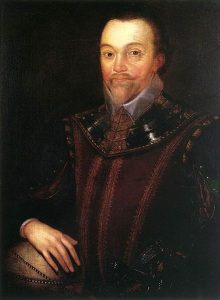
In 1581, Sir Francis Drake was made mayor of Plymouth. A city in southwest England. At the time Drake was a famous Hero, and so he was a popular Mayor. He introduced a water supply, which the city used for 300 years. He married a woman there named Elizabeth Sydenham. She was the heiress to a rich man in Devonshire. While there, he bought an expensive country house, Buckland Abbey, but this was no easy feat, and he only managed to gain it by tricking the buyers. You see, the owners hated Sir Francis Drake with a passion. They hated his west country mannerism, and felt he didn’t behave as a man in his position should. They never would have sold him the house, but he managed to obtain by getting them to think it was going to another party.
Singeing The King Of Spain’s Beard
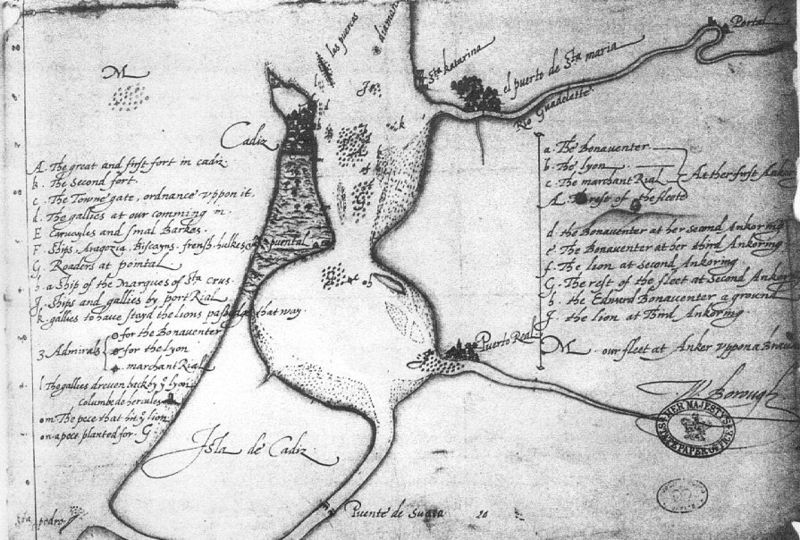
Drakes map of his attack on Cadiz
Phillip II of Spain was intent on invading England and overthrowing Queen Elizabeth. This invasion was supported by Pope Sixtus V, who treated it as a crusade, and promised them subsidy if they could land on England. Sir Francis Drake sailed into Spain’s main ports, Cadiz and Corunna, with a fleet. While occupying the harbours he destroyed almost 40 ships, which ended up delaying Spain’s attack for another year. He spent the next year robbing Spanish ships.
His Defeat Of The Spanish Armada 1588
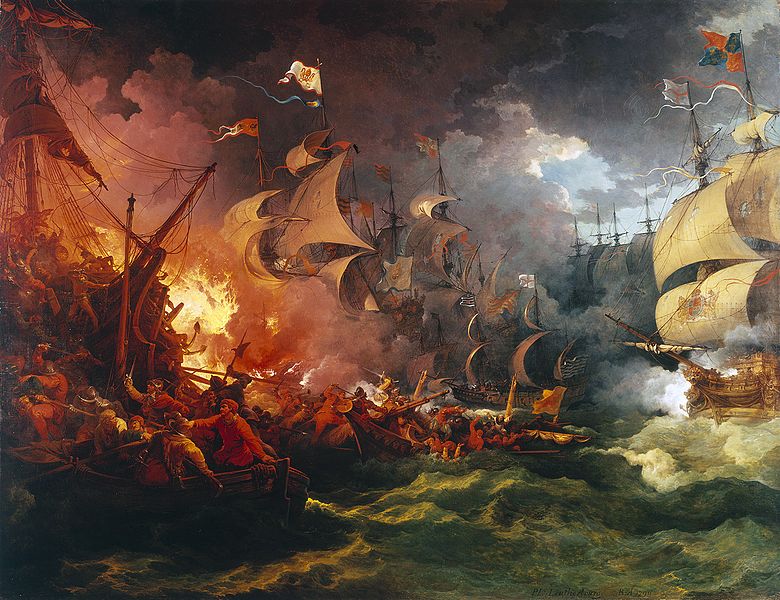
When Spain was finally able to invade again, they came with a fleet of 140 ships known as the Spanish Armada. Drake was Vice Admiral, and his ship’s lantern was leading the rest of the English fleet through the darkness. Drake broke off to chase after and capture the Spanish ship Rosario, which was an important ship carrying many of the Spanish soldier’s wages. When he broke formation, however, it left the English fleet in disarray. It took a day for them to reorganise. On 28th July the English set fire to 8 ships, and sent them towards the Spanish, who panicked and broke formation. They were then defeated at the Battle of Gravelines. The fireships were Drake’s idea.
Drake-Norris Expedition
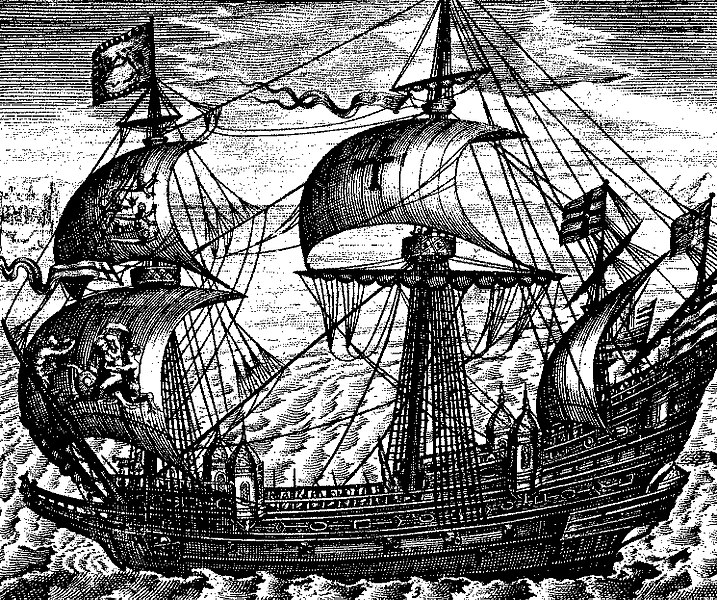
It was one year after their defeat of the Spanish, and Drake had been given the task of finding the remaining ships of the Spanish Armada and destroying them, as well as supporting the rebels in Lisbon, and if possible, capturing the Azores (a region in Portugal). Drake led the English Armada on Spain but unfortunately failed to capitalise on the victory he had gained over the Spanish. They were forced to retreat, and it resulted in the rise of Philip II’s naval power.
His Death
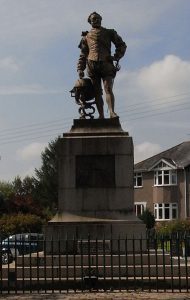
Drake had a near death experience in 1595, when he was in his mid fifties. A cannon ball ripped through his cabin, but he survived the event. His actual death happened a year later, when he died of Dysentery. He was buried at sea in his full suit of armour, in a coffin lined with lead.




